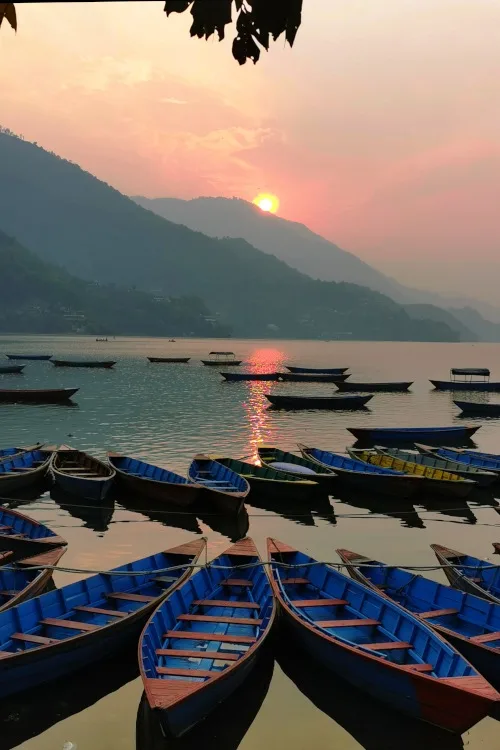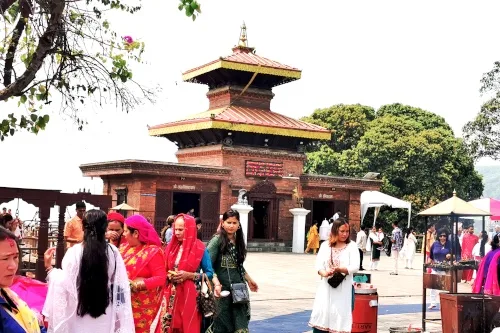
Are you thinking about visiting Nepal for your next holiday? If so, you'll want to check out all the places to visit in Pokhara, the second-largest city in Nepal. We've also written another article about the top places to visit in Kathmandu, which you can find here.
Our local Nepal tour company, Grande Adventure, handpicked a list of places for us to visit in Pokhara. We managed to cover all these wonderful spots in just two days during our visit to Pokhara, as we dedicated most of our time to the Annapurna Base Camp Trek. Since most visitors to Nepal spend about two days in Pokhara, our recommendations will be a perfect guide for you as you plan your trip.
1️⃣ World Peace Pagoda in Pokhara
Our first stop was the Shanti Stupa, the World Peace Pagoda. This beautiful landmark symbolizes peace and unity and is atop a small hill. We had to climb around 480 rock steps to reach it, which took only about ten minutes.


From the top of the hill, we enjoyed a breathtaking panoramic view of the Annapurna range and Phewa Lake.
The pagoda was built in 1999 as part of a global initiative to construct 100 peace pagodas worldwide. It stands 115 feet tall and 344 feet wide, with two tiers featuring four Buddha statues representing different countries and important events related to Buddha's life.

The entrance features a giant statue of Lord Buddha in dharma chakra Pravartan posture from Japan. Additionally, on the west side, there is a statue of Lord Buddha in meditation posture from Sri Lanka, a six-foot-long Mahaparinirvana statue of Lord Buddha in bronze from Thailand on the north side, and a bronze statue depicting Buddha's birth from Nepal on the south side.

Upon entering the pagoda, our guide informed us that TikTok and video recording are prohibited to maintain a tranquil atmosphere. However, taking photos is permitted.




2️⃣ Devi’s Falls

We visited Devi's Falls once in Pokhara twenty years ago. Most of my memories of the falls have faded, and I feel like I was visiting a place I have never been before.

Devi's Falls, also known as Patale Chango, is a famous waterfall and a significant landmark of Pokhara.
The waterfall is fed by the Phewa Lake Dam and is surrounded by lush flora. As the water reaches the bottom, it forms a 500-foot-long underground tunnel 100 feet below ground level. This unique natural phenomenon gives the falls its Nepali name, "Patale Chango," which translates to "Underworld's Waterfall."
After exiting the tunnel, the water passes through Gupteshwor Mahadev Cave across the road.
We visited Devi's Falls during the dry season, so there was little water flowing. The best time to visit Devi's Fall in Pokhara, Nepal, is during the monsoon season from June to September. During this period, the water is at its peak due to the heavy rains, creating a stunning display of water cascading down the rocks. However, the heavy rainfall can also make the area around the falls slippery and potentially dangerous.

The origin of the name "Devi's Fall" is attributed to a local legend. According to the signboard at the fall, on the noon of 31 July 1961, Mrs. Davis, a Swiss citizen, was swept away while taking a bath with her husband a few meters ahead of the fall, and she died. Her dead body had been taken out with a lot of effort. The despairing husband suggested naming the fall after his late wife as a tribute to her. Thus, the name "Devi's Fall" was given to the waterfall.
3️⃣ Gupteshwor Mahadev Cave

Once we finished checking out Devi's Falls, we returned to the entrance and crossed the road to Gupteshwor Mahadev Cave. It's cool because the water from Devi's Fall flows underneath the road we cross, enters the cave, and emerges again. The cave is about 2057 meters long and is one of the most attractive caves in South Asia. Legend states that a local man stumbled upon this cave in the 16th century while clearing grass.

After we passed the entrance, a beautiful red spiral staircase led down to the mouth of the cave. Inside the cave are small shrines dedicated to Lord Shiva, who is really important to Hindus. Unfortunately, we were not allowed to take photos at the shrines, but seeing it's still pretty impressive.

As we explore further into the cave, we'll walk through narrow passages, down slippery stairs, and find ourselves in giant open caverns. Over there, we'll reach a beautiful waterfall that flows through the cave, coming from Devi's Falls.

from Devi's Falls. )
4️⃣ Shree Bindhyabasini Temple
Bindhyabasini Temple is a well-known temple in Pokhara dedicated to the Hindu goddess Bindhyabasini, who is believed to be the city's guardian deity. We decided to visit this place while on our way back from Sarangkot, as recommended by a Nepalese we knew in Malaysia before embarking on our journey.

The temple is perched on top of a small hill about 3002 feet above sea level, and let me tell you, the view of the Himalayas from there is breathtaking.

This temple has an interesting history—it dates back to the 1760s when King Girvan Yuddha Bikram established it. Legend has it that the king dreamt of building a temple for the goddess, and that's how the Bindhyabasini Temple came to be in its current location in Pokhara.
The temple itself is just stunning. It's built in the Shikhara style and has a white pagoda structure with a beautiful golden-carved metal gate. And get this—two golden metal lions guard the entrance.

The temple complex houses shrines dedicated to deities like Saraswati, Hanuman, Shiva, Vishnu, Ganesh, and Jogi Paati. But the main temple is, of course, devoted to Bindhyabasini.
The temple premises have a lift that can hold up to 12 people, so we don't have to worry about climbing all those stairs. We took the lift, and it was a breeze!

The temple was packed with worshippers when we visited, probably because of the Nepalese New Year. But even for us, who are only visitors, we still enjoyed the park-like surroundings and checked out other nearby temples celebrating different deities.
5️⃣ Phewa Lake
Phewa Lake (also called Phewa Tal or Fewa Lake) is a beautiful freshwater lake in Nepal's Pokhara Valley. This stunning lake is the second-largest in Nepal and the largest in Gandaki Province.

Legend has it that a goddess disguised as a beggar once roamed the Himalayan Valley, but the locals didn't treat her well. As a result, a flood swept through the area, forming the breathtaking Lake Phewa. This tale adds a touch of mystique to the lake's natural beauty.

One of the most important places to visit at Phewa Lake is the Tal Barahi Temple, a Hindu temple situated on an island in the middle of the lake. The temple can only be reached by boat, making it a truly unique and picturesque spot.
6️⃣ Gaurighat Park
Gaurighat Park is a scenic park located along the serene shores of Phewa Lake in Pokhara. It is one of the best places to visit in Pokhara, especially if you are looking for tranquil and stunning lake views.

The park offers a peaceful and serene environment, ideal for relaxation and recreation. While strolling through the park, we enjoyed scenic views of the lake and the surrounding mountains.

Gaurighat Park is just a ten-minute walk from Hotel Mount View Pokhara, where we stayed.
7️⃣ Tal Barahi Temple
The Tal Barahi Temple is one of the best places to visit in Pokhara. It is situated on a small island in the middle of Phewa Lake and is dedicated to the Hindu goddess Barahi, a manifestation of Durga.

The temple is believed to have been built by King Kulmandhan Shah in response to his dream. What's unique about this temple is that it's the only one of its kind in Nepal, as it's situated entirely within a lake with no land passageways.

During my visit, we hired a boat and sailed to the island where the temple is located. The island is pretty small, and it was full of worshippers. Seeing thousands of locals lined up to perform their worship was amazing.
The temple is built in the traditional pagoda style using wood, bricks, and stone. The main shrine has a premise large enough to accommodate many devotees, and there are seats where visitors can sit and meditate.
After that, we took a boat ride from the temple and explored the surrounding Phewa Lake, which is Nepal's second-largest lake. It was a wonderful experience!
8️⃣ The Evening Aarti possession
Before dinner, we witness the evening Aarti procession. This special event takes place on the bank of Phewa Lake in Pokhara, right opposite the Tal Barahi Temple.

The atmosphere was amazing, with a huge crowd, beautiful rituals, soulful songs, and traditional dances, all taking place just after sunset.

The highlight of the procession is the Aarti ceremony, during which devotees wave lamps in a circular motion while singing devotional songs. It's heartwarming to see devotees offering prayers and flowers, seeking the goddess's blessings and protection.
The event features lively traditional Nepalese music, captivating dance performances, and chanting, creating a truly festive atmosphere.

➡️ More about our trip to Nepal
This is the complete list of the places to visit in Pokhara during our two-day stay, and I hope it is informative enough for you to use it as a guide to plan for your visit. Besides Pokhara, we also have travel to other part of Pokhara:
- Lumbini. We flew a day to Lumbini from Pokhara to visit the birthplace of Buddha. Whether you are a Buddhist or not, it is a worthwhile trip as it is one of Nepal's most significant UNESCO sites.
- Kathmandu. We also spent two days in Kathmandu, the capital of Nepal. You can read our story about Kathmandu here.
- Annapurna Base Camp Trek. We spent about nine days taking on the Annapurna Base Camp Trek. Trek started from Hille via Poon Hill and eventually reached the ABC Camp. This track is considered one of the most beautiful hiking treks in the world, covering landscape ranges from dense forests to rocky trails to glaciers and trekking on snow. You can read our story here, where we successfully reached ABC.
🎞️ Watch our video shot in Pokhara, Nepal
Please watch the video we made for our trip on YouTube. As below:

VJ Tamang, owner and tour guide of Grande Adventure, expertly organized and made our trip enjoyable. VJ can be contacted at https://www.grandeadventure.
